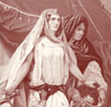


Alison Booth
An American Lady [Ann Hasseltine Judson]. Sketches of the Lives of Distinguished Females: Written for Girls, with a View to Their Mental and Moral Improvement. New York: Harper, 1833. Reprint 1837. By Anne Hasseltine Judson, 1847; 1854.
An educational dialogue by the celebrated, first “Mrs. Judson," according to some library records. Anne Judson is the subject of the last chapter, and so perhaps there would have been more incentive for anonymity. The Preface begins with the idea of biography as example especially influential on the young female. Judson disclaims originality; the biographies derive from existing records. Because some women are dangerous models, she selects and shapes the narratives for good effect on readers while avoiding allusion to sectarian differences (all are "Christians"). According to custom, she apologizes for necessary limits on the selection. The Introduction consists of a dialogue between a daughter, Mary, and her mother "Mrs. G." (presumably the same as Mrs. Grenville in the opening chapter) relating an anecdote about a man who gave a boy a biography of Benjamin Franklin because it had such an influence on his own life. "Are there no histories of good and great women, mother?" (xiv). The mother plans a weekly evening sewing circle of young girls to which she can read aloud selectively, with moral annotation, the appropriate model lives of women (as some historic women are misleading guides for the kind of daughter she would wish to raise). Mrs. Grenville gathers "engraved portraits" as well as biographies for this book club (no illustrations appear in the Google Book version). An interesting passage depicts Mary arranging the parlor for guests, tending her house plants and placing flowers. The first evening, each girl is catechised on the kind of woman she wants to be, and Mrs. G. affirms that they do not all need to follow the same model, but all should be devout, and any learned accomplishment should be accompanied by good housekeeping skills (here an apt quotation of Hannah More). The chapters follow the series of supposed evening meetings. There is no table of contents (though running headers name the women). Mrs. G. comments on the shift from historical grandeur to examples that her auditors might plausibly emulate. One evening is dedicated to Elizabeth Smith, born near Durham, England, in 1776; remarkable for learning (a translator); exemplary for her good cheer and resourcefulness when her family loses its wealth (as happens more frequently in America); known as resident of Coniston and subject of a poetic tribute and a biography after her death of tuberculosis. The following evening on the poet Davidson explicitly compares the two women, though favoring the latter for her productivity in poetry (examples given). Mrs. Graham was stranded as a widowed mother, during Revolutionary War, in Antigua; became a philanthropist in New York. Mrs. Judson's life takes up the final, eighth evening, with a concluding summary of the examples reviewed.
TOC: Semiramis; Cleopatra; Zenobia; Isabella Queen of Castile; Lady Jane Grey; Queen Elizabeth I; Mary Queen of Scots; Queen Christina of Sweden; Lady Rachel Russel; Elizabeth Smith; Lucretia Maria Davidson [1808-1825]; Mrs. Isabella Graham [nee Marshall, b. Scotland 1742]; Mrs. Judson.
Search OCLC WorldCat for this title.
Search Google Books for this title.